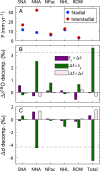The Greenland spatial fingerprint of Dansgaard-Oeschger events in observations and models
- PMID: 39432793
- PMCID: PMC11536073
- DOI: 10.1073/pnas.2402637121
The Greenland spatial fingerprint of Dansgaard-Oeschger events in observations and models
Abstract
Pleistocene Ice Ages display abrupt Dansgaard-Oeschger (DO) climate oscillations that provide prime examples of Earth System tipping points-abrupt transition that may result in irreversible change. Greenland ice cores provide key records of DO climate variability, but gas-calibrated estimates of the temperature change magnitudes have been limited to central and northwest Greenland. Here, we present ice-core δ15N-N2 records from south (Dye 3) and coastal east Greenland (Renland) to calibrate the local water isotope thermometer and provide a Greenland-wide spatial characterization of DO event magnitude. We combine these data with existing records of δ18O, deuterium excess, and accumulation rates to create a multiproxy "fingerprint" of the DO impact on Greenland. Isotope-enabled climate models have skill in simulating the observational multiproxy DO event impact, and we use a series of idealized simulations with such models to identify regions of the North Atlantic that are critical in explaining DO variability. Our experiments imply that wintertime sea ice variation in the subpolar gyre, rather than the commonly invoked Nordic Seas, is both a sufficient and a necessary condition to explain the observed DO impacts in Greenland, whatever the distal cause. Moisture-tagging experiments support the idea that Greenland DO isotope signals may be explained almost entirely via changes in the vapor source distribution and that site temperature is not a main control on δ18O during DO transitions, contrary to the traditional interpretation. Our results provide a comprehensive, multiproxy, data-model synthesis of abrupt DO climate variability in Greenland.
Keywords: Dansgaard–Oeschger cycle; Greenland; ice cores; paleoclimate; water isotopes.
Conflict of interest statement
Competing interests statement:The authors declare no competing interest.
Figures




References
-
- Robinson A., Calov R., Ganopolski A., Multistability and critical thresholds of the Greenland ice sheet. Nat. Clim. Change. 2, 429–432 (2012).
-
- deMenocal P., et al. , Abrupt onset and termination of the African Humid Period: Rapid climate responses to gradual insolation forcing. Quat. Sci. Rev. 19, 347–361 (2000).
-
- Armstrong McKay D. I., et al. , Exceeding 1.5°C global warming could trigger multiple climate tipping points. Science 377, eabn7950 (2022). - PubMed
-
- Dansgaard W., et al. , Evidence for general instability of past climate from a 250-kyr ice-core record. Nature 364, 218–220 (1993).
-
- Birner B., Hodell D. A., Tzedakis P. C., Skinner L. C., Similar millennial climate variability on the Iberian margin during two early Pleistocene glacials and MIS 3. Paleoceanography 31, 203–217 (2016).
Grants and funding
LinkOut - more resources
Full Text Sources

